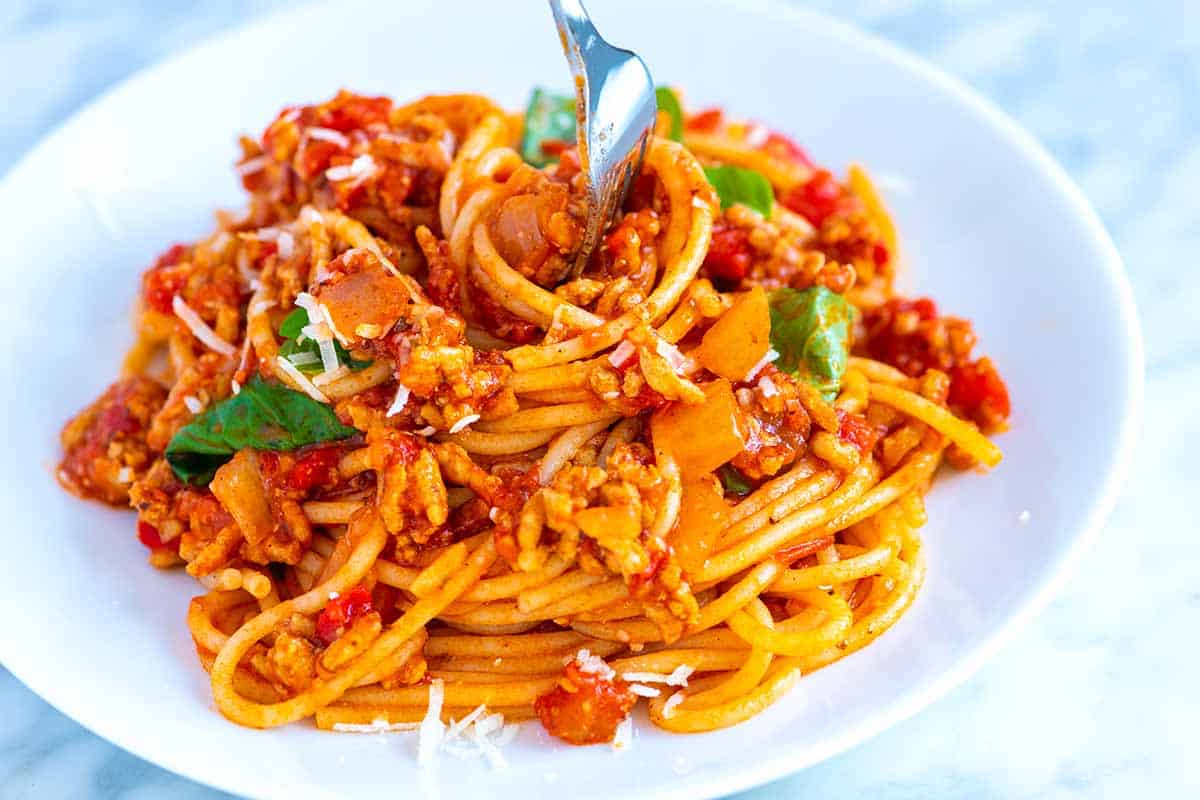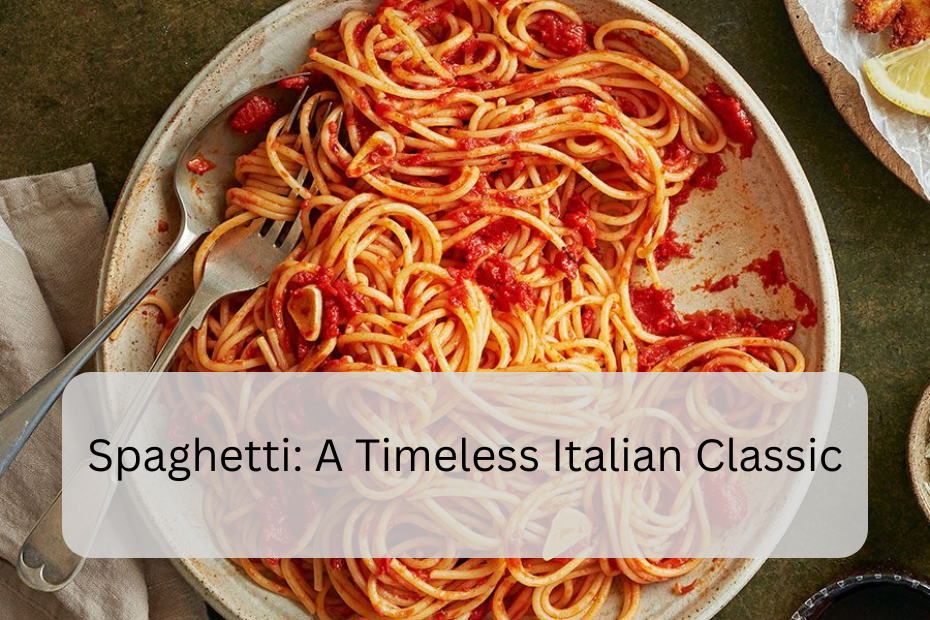Spaghetti is one of the most iconic and beloved dishes in Italian cuisine, enjoyed by people around the world. Its origins date back centuries, and over time, it has evolved into countless variations, each bringing its own unique flavor and character. Whether served with a simple tomato sauce, hearty meatballs, or sophisticated seafood, spaghetti remains a comforting and versatile dish that can be adapted to suit any occasion. In this article, we will explore the history of spaghetti, detail the essential ingredients, provide a comprehensive preparation guide, offer serving suggestions, answer frequently asked questions, and conclude with why spaghetti is a timeless favorite.
History and Origins

Spaghetti, which means “little twine” in Italian, is believed to have originated in Southern Italy. Its history can be traced back to ancient times, with early versions of pasta being made by the Etruscans and Romans. However, it was during the 12th century that the modern version of spaghetti began to take shape in Sicily, influenced by Arab traders who introduced durum wheat, a key ingredient in pasta making.
Over the centuries, spaghetti became a staple in Italian cuisine, particularly in Naples and other southern regions. By the 19th century, it had gained popularity across Italy and eventually around the world, thanks to Italian immigrants who brought their culinary traditions with them. Today, spaghetti is synonymous with Italian food and continues to be a favorite in homes and restaurants globally.
Ingredients
The ingredients for a classic spaghetti dish are simple, yet they come together to create a delicious and satisfying meal. Here are the basic components:
- Spaghetti: The star of the dish, made from durum wheat semolina. Choose high-quality spaghetti for the best texture and flavor.
- Olive Oil: Extra virgin olive oil is preferred for its rich taste and health benefits.
- Garlic: Adds a fragrant and flavorful base to the sauce.
- Tomatoes: Fresh tomatoes or canned crushed tomatoes are essential for a traditional marinara sauce.
- Basil: Fresh basil leaves provide a burst of herbal flavor.
- Salt and Pepper: Essential seasonings to enhance the taste.
- Parmesan Cheese: Freshly grated Parmesan adds a rich, umami flavor.
Optional ingredients for variations:
- Ground Meat: Beef, pork, or a combination for a meaty sauce.
- Onions: Adds sweetness and depth to the sauce.
- Red Pepper Flakes: For a hint of heat.
- White or Red Wine: Adds complexity to the sauce.
- Seafood: Such as clams, shrimp, or mussels for a seafood variation.
Preparation
Preparing spaghetti involves a few key steps to ensure the pasta and sauce are perfectly cooked. Here’s a step-by-step guide:
- Cook the Spaghetti:
- Bring a large pot of salted water to a boil.
- Add the spaghetti and cook according to the package instructions until al dente (firm to the bite), usually 8-10 minutes.
- Drain the spaghetti, reserving about 1 cup of the pasta cooking water.
- Prepare the Sauce:
- Classic Marinara Sauce:
- Heat 2 tablespoons of olive oil in a large skillet over medium heat.
- Add 3-4 minced garlic cloves and sauté until fragrant, about 1-2 minutes.
- Add 1 can (28 ounces) of crushed tomatoes, a handful of torn fresh basil leaves, and season with salt and pepper.
- Simmer the sauce for 15-20 minutes, stirring occasionally. If the sauce is too thick, add a bit of the reserved pasta water to reach the desired consistency.
- Meat Sauce:
- In the same skillet, heat 2 tablespoons of olive oil over medium heat.
- Add 1 finely chopped onion and sauté until translucent, about 5 minutes.
- Add 1 pound of ground beef or pork and cook until browned, breaking it up with a spoon.
- Add 3-4 minced garlic cloves and cook for another minute.
- Stir in 1 can (28 ounces) of crushed tomatoes, 1 teaspoon of dried oregano, and a pinch of red pepper flakes (if using).
- Simmer for 20-30 minutes, stirring occasionally. Adjust seasoning with salt and pepper.
- Combine and Serve:
- Add the cooked spaghetti to the sauce in the skillet and toss to combine, ensuring the pasta is evenly coated with the sauce.
- If the sauce is too thick, add some of the reserved pasta water until the desired consistency is reached.
- Serve the spaghetti hot, topped with freshly grated Parmesan cheese and additional fresh basil, if desired.
Serving Suggestions

Spaghetti is incredibly versatile and can be served in many ways. Here are some ideas:
- Classic Spaghetti and Meatballs: Serve the spaghetti with homemade meatballs and marinara sauce, topped with grated Parmesan.
- Spaghetti Aglio e Olio: A simple yet flavorful dish made with olive oil, garlic, red pepper flakes, and parsley.
- Seafood Spaghetti: Toss the spaghetti with a mix of sautéed seafood such as shrimp, clams, and mussels in a white wine and garlic sauce.
- Spaghetti Carbonara: A creamy, rich pasta dish made with eggs, Parmesan cheese, pancetta, and black pepper.
- Spaghetti Bolognese: A hearty meat sauce made with ground beef, tomatoes, onions, carrots, celery, and red wine.
FAQ about Spaghetti
Q: Can I use whole wheat or gluten-free spaghetti?
A: Yes, whole wheat and gluten-free spaghetti are great alternatives. Cook them according to the package instructions, as they may have different cooking times than regular spaghetti.
Q: How do I prevent the spaghetti from sticking together?
A: Stir the spaghetti occasionally while it cooks and add a bit of olive oil to the boiling water. Tossing the cooked spaghetti with a little olive oil can also help.
Q: Can I make the sauce ahead of time?
A: Yes, you can make the sauce ahead and refrigerate it for up to 3 days or freeze it for up to 3 months. Reheat the sauce on the stovetop before tossing it with the cooked spaghetti.
Q: What’s the best way to reheat leftover spaghetti?
A: Reheat spaghetti in a skillet over medium heat with a splash of water or extra sauce to prevent it from drying out. Alternatively, microwave it in a covered dish with a little water.
Q: Can I add vegetables to my spaghetti?
A: Absolutely. You can add sautéed vegetables such as bell peppers, zucchini, spinach, or mushrooms to the sauce for added nutrition and flavor.
Q: How do I know when the spaghetti is al dente?
A: Al dente means “to the tooth” in Italian, indicating that the pasta should be firm to the bite. Taste the spaghetti a minute or two before the package’s suggested cooking time. It should be cooked through but still have a slight firmness.
Conclusion
Spaghetti is a timeless classic that embodies the essence of Italian cuisine. Its simplicity, versatility, and delicious taste make it a favorite for meals at any time of the day. From a basic marinara to elaborate seafood variations, spaghetti offers endless possibilities to suit any palate.
This beloved dish’s rich history and widespread popularity are testaments to its universal appeal. Whether you are cooking for a family dinner, hosting a casual gathering, or preparing a quick meal, spaghetti is a go-to choice that never disappoints. By mastering the basic techniques and experimenting with different ingredients and sauces, you can create a wide range of dishes that showcase the enduring charm of spaghetti.
Embrace the tradition, savor the flavors, and let spaghetti bring a touch of Italy to your table. With its comforting taste and endless adaptability, spaghetti will remain a cherished part of your culinary repertoire for years to come.
Read Also: Swedish Pancakes: A Delicate Delight
